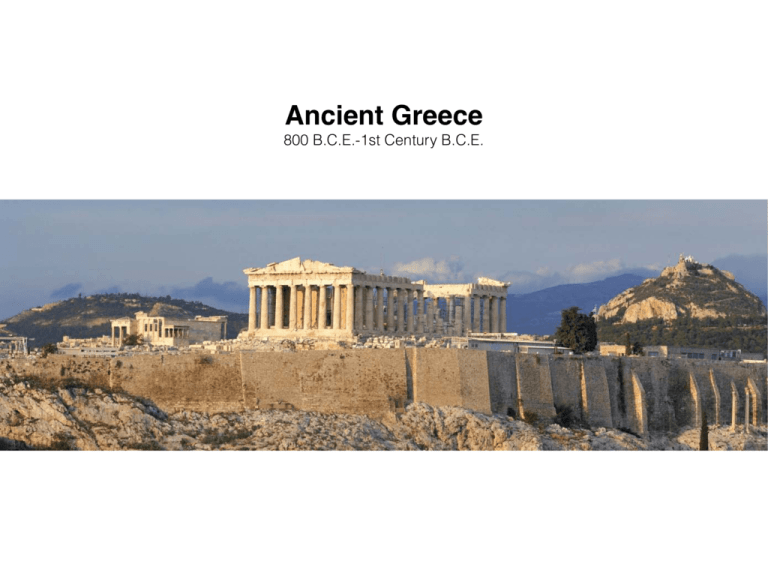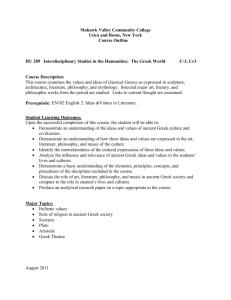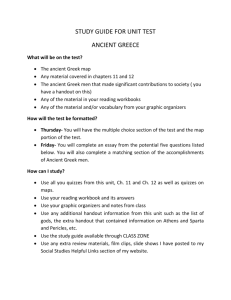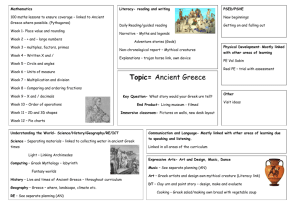Syllabus
advertisement

Ancient Greece 800 B.C.E.-1st Century B.C.E. Origin of Ancient Greek Culture" 800 B.C.E.-1st Century B.C.E. The Mycenaean dominance collapsed around 1,100 B.C.E. This was due to other aggressive invaders who were crossing into mainland Greece. 1100-900 B.C.E. were a kind of “Dark Age” for this region. A new culture was brewing, ready to come to the forefront. Due to geography, this fusion of new migrants and earlier inhabitants became Greek. Small, close knit communities formed (all of them speaking some form of the same language). Overview of Greek Culture Acropolis of Athens, a noted polis of classical Greece. From these small communities, in 800-700 B.C.E., they developed city-states (polis). An autonomous region with a city as its political, economic, religious and cultural center. 600 B.C.E. Greeks adopted two very sophisticated, new tools from the Asia Minorcoins and alphabetic writing. The context of Greek Civilization at this time Those who didn’t speak Greek were “Barbarians” Concept of Human-Supremacy and Responsibility Production of Oil, Wine, Metal and Ceramic Vases By the end of 500 B.C.E., Athens had a representative government (or “deme” —> where the word “democracy comes from”) in every community where they had their own assembly and magistrates. (This was a NEW concept in governance) -All citizens participated in the assembly and all had equal right to own private property, to serve in the Army + Navy, to vote, hold public office and exercise free speech. -At this time, Citizens = Free Males According to the 309 B.C.E. Census, it lists a total of: 21,000 Citizens 10,000 Foreign Residents 400,000 “Others” (Women, Children and Slaves) Greek Colonies included areas in Italy, Sicily and Asia Minor. They were independent commercial and cultural centers themselves (but still shared the same language, traditions, religion and history) Greek Religion The creation of the world involved a battle between earth gods (Titans/Giants) and the sky gods. The Victors The Greeks saw their gods as immortal, embodied in human form, possessing supernatural powers and giving them human weaknesses and emotions. Geometric Period 900-700 B.C.E. (Named after the style of the decorations on ceramic vessels) Primary source of information about Greek Art before the 7th Century- Pottery Use of Linear Motifs- spirals, diamonds and cross-hatching -and- Lacking in human and animal body parts in sculptural works. This artifact was a bit of an unusual find, hollowed body, like a vase on a potter’s wheel. Centaurs were predominant in Greek mythology, this work, found in a cemetery, have been deliberately broken into and found buried in adjacent graves, may have symbolized the dual good side and bad side of humans. Centaur Terra Cotta Late 900 B.C.E. These were discovered in the Ancient Cemetery of Athens (Dipylon Gate) Provided a detailed record of funerary Rituals —> including the new Greek practice of cremation Arms raised, both hands placed on top of their heads—> expressing anguish and grief. No 3-Dimensional figures, full frontal of full profile views that emphasize flat patterns and outline shapes. Greek funerary art focused on the emotional reactions of the survivors rather than the fate of the dead —-> The deceased entering into a place of mystery and obscurity. Funerary Vase Terra Cotta 750 B.C.E. Discovered in the Ancient Cemetery of Athens (Dipylon Gate) Geometric Amphora Terra Cotta 700 B.C.E. Metalworking was also predominant during this era- Man and Centaur Bronze 750 B.C.E. Orientalizing Period c.700-600 B.C.E. At this point, compositions were built around large motifs that included real and imaginary animals, abstract plant forms, and human figures. Shapes were more curved than the works from the Geometric style. This originally served as the funerary vase for a child. The scene is the earliest identifiable depictions of scenes from Greek mythology! Odysseus and his men in this scene is blinding the Cyclops Polyphemos who had eaten Odyesseus’ sailors. Polyphemos Painter Amphora Terra Cotta 675-650 B.C.E. We can see that during this time period, this painter is shifting into more 3-Dimensional figures. Influence of Egyptian and Near Eastern Art on Greek Pottery (spread through trading contacts) Silhouetted creatures striding in horizontal bands against a light background with stylized flower forms called “rosettes” Decorated with dark shapes of lions, a serpent, and composite creatures against a background of the natural color of the Corinthian clay. Along with the incised fine details inside the silhouetted shapes, the added touches of the white and reddish purple gloss (clay slip mixed with metallic color pigments), to enhance the design. Pitcher (Olpe) from Corinth Ceramic with Black-Figure Decoration 600 B.C.E. Terrance of the Lions Marble 610 B.C.E. Erected and dedicated to Apollo by the people of Naxos just before 600 BCE, the terrace consisted of a row of nine to twelve marble carved lions that faced eastward towards the Sacred Lake of Delos along the Sacred Way from Skardana Bay to the temples. The lions, with their mouths open as if roaring or snarling, were both meant to guard the sanctuaries and to inspire a feeling of divine fear among the worshippers. Today, only five of the original lions remain with remnants of three others and the headless body of another has been transported and put over the main gate of a Venetian arsenal. The lions create a monumental avenue comparable to Egyptian avenues of sphinxes… Wait a second…Lions in Greece- ? Yes! Lions did exist in southern Europe, accounts of them have been written and depicted in vases. They are featured heavily in Ancient Greek mythology and writings. There was an ancient belief that Lions slept with their eyes open. The depictions of Lions were used as symbolism- protection and is typically associated with the sun. For the Terrance of the Lions, they were used to “protect the birthplace of Apollo and Artemis”. Archaic Period 600-480 B.C.E. Athens starting the emerge to be the largest Greek city-state in the region, increasing in population, economic development, moving artistically, commercially and politically to the forefront. Aesop started to write his fables at this time. Artists were competing for lucrative commissions from government and wealthy individuals. (Building temples, shrines, government buildings, monumental sculpture and fine ceramic wares). Potters and Vase painters were starting to sign their work. Freestanding Sculpture Many of the identities are still somewhat unknown, whether they were depicting athletes, gods/goddesses, priests/priestesses and warriors. Kouros- Male, Typically nude, some partially clothed to display their status Kore- Female, Always clothed We can start to see the similarities between the sculptures of Ancient Greece and Ancient Egypt, just like many Egyptian statues, Kouros were typically depicted frontally, arms positioned rigidly at his sides, fists clenched and one leg slightly in front of each other. New York Kouros, from Attica Marble 580 B.C.E. Archaic Smile Eyes were large and open, and the mouths form a characteristic closed-lip smile known as the Archaic smile (used to enliven the expressions in the figures). Found from a cemetery near Athens, the Anavysos Kouros served as a grave monument to a fallen war hero. At the base of the statue was an inscription saying: “Stop and grieve at the tomb of the dead Kroisos, slain by the wild Ares [god of war] in the front rank of battle.” Anavysos Kouros Marble 525 B.C.E. Archaic Smile One of the earliest Kore sculptures ever made. Wearing a crown and holding a pomegranate in her hand, indicates that this could be Persephone, goddess of fertility and abducted queen of the underworld. It’s assumed that many Kore sculptures were representing her. Berlin Kore Marble 570-560 B.C.E. Archaic Smile Peplos Kore Marble 530 B.C.E. Pottery during the Archaic Period When it came to pottery, artists at this time were refining their styles and experimenting with new compositions. Red Figure (red color on a black background) Black Figure (black color on a red background) were becoming predominant during this time Athens became the dominant center for pottery manufacture and trade in Greece. Painters adopted the Corinithian black-figure techniques, painters kept the horizontal banded composition (from the Geometric Period) This large mixing bowl for wine and water was found in an an Italian Tomb. The civilization during ~570 B.C.E. was known to be Etrusian. They greatly admired and collected Greek pottery. It is suggested that they also brought in Greek artists to teach their local artists. Earliest known vessel to be signed by the potter and painter. Ergotimos (potter) and Kleitias (painter) François Vase Black- Figure decoration on a volute krater c.570 B.C.E. This particular piece was loaded with pictorial and literary records of Ancient Greek religion/history. Funeral games- in honor of Achilles’ close friend who died in the Trojan War The marriage of Peleus (King of Thessaly) and Thetis (Sea Nymph) - Parents of Achilles (Greek Hero of the Trojan War) The ambush of the Trojan prince Toilus by Achilles The number of bands started to decrease, as was the decoration, landscape was incorporated and the size of the figures were increasing to where artists would depict a story on one side. Exekias Achilles ad Ajax Playing a Board Game Black-figure Terra Cotta Amphora c.540-530 B.C.E. In this scene, Exekias depict these two Greek opposing heros of the Trojan War into rival players of a board game. The postures are more 3-Dimensional. Achilles, shown with his helmet on and hovering a little bit higher than his opponent gives us a clue that Achilles is the victor in this game. We can start to see the similarities with Greek Theatre and these illustrations in expression and scene. Exekias The Suicide of Ajax Black-figure decoration on an amphora Ceramic c. 540 B.C.E. Classical Style c. 480-320 B.C.E. Based on three general concepts, humanism, rationalism and idealism. Carved on the Temple of Apollo: “Man is the Measure of All Things” (Seek an Ideal based on human form) “Know Thyself” (Seek the inner significance of forms, valuing reason over emotion) “Nothing in Excess” (Reproduce only essential forms) Socrates, Plato, Aristotle convinced that logic and reason underlie natural processes, and that all aspects of life, including the arts have meaning and pattern (nothing happens by accident) Close observations in nature informed artists’ practice, but even with that, artists would still produce work as idealized forms. (Developed a system of perfect mathematical proportions) This rationalism provided an intellectual structure for the arts, and can be seen in the creation of the orders in architecture, and sculpture. Artists and Architects were not only practitioners, but they were theoreticians themselves. Sculptor Polykleitos and Architect Iktinos both wrote books on theory underlining their practice. Philosophers such as Aristotle and Plato have always discussed the role of art to a society. The two even debated about it. From the dialogue, The Republic, Plato: saw art as an imitation of an “abstract ideal world”, an illusion, from those who were born with the talent. Aristotle: however believed that an artist can be created by learning, and that art is an imitation in the form of a true idea. (Aristotle was also a student of Plato) The School of Athens, Raphael. Fresco Mural, 1510-1512 A.D. Between 462-429 B.C.E. Pericles, the leader of Athens, was a great patron of the arts encouraging artists to promote a public image of peace, prosperity and power. “future generations will marvel at us, as the present age marvels at us now.” Pottery during the Classical Period Artists were still using the Red-Figure technique, BlackFigure and White Ground Pan Painter Artemis Slaying Actaeon Red-figure decoration on a bell krater Ceramic 470 B.C.E. Inspired by the less-heroic myths of the gods, Pan Painter depicts Actaeon, while out hunting stumbled upon Artemis (goddess of the hunt) taking a bath. The enraged goddess caused Actaeon’s own dogs mistake him for a stag and to attack him. Lekythoi were used to pour an offering during religious rituals. Some lekythoi convey grief and loss, with scenes of departing figures bidding farewell. They were typically found on graves. Reed Painter Warrior by a Grave White Ground on Lekythoi Terra Cotta c.410 B.C.E. Sculpture during the Classical Period Marble and Bronze Sculpture dominated this period of time. Figures were posed more causal, and here we can see the development of the contrapposto pose. (Presenting standing figures with opposing alterations of tension land relaxation around a central axis) Contrapposto Pose Kritios Boy Marble 475 B.C.E. In this larger-than-life figure, we can see the veins on the arms and legs of this sculpture. Contrapposto Pose Warrior from Riace Bronze c.460-450 B.C.E. Bronze being the easier material to work with, sculptors were able to create more complex action poses with outstretched arms and legs. Next Wednesday is our Second Exam! It will cover the readings and lectures of: *Ancient Egypt *Aegean Culture *Ancient Greece Monday will be our review day









